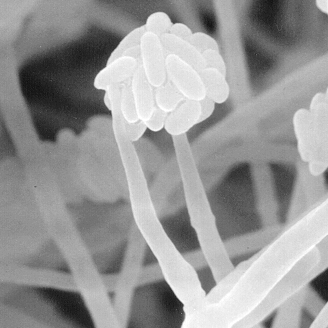|
 As primary
producers of organic matter, plants constitute an
attractiveVerticillium habitat for micro-organisms. Different types of
interactions are described like killing of infected cells by
necrotrophic fungi, exploitation of resources from living host cells by
biotrophic pathogens, and symbiotic interactions which benefit both
sides. The life style of the soil-borne, vascular fungal pathogen Verticillium longisporum (VL)
constitutes still another form of interaction. Here, the fungus
persists for a long time in the xylem of its host without causing
severe damage. In general, stunting and early senescence are observed
during this stage. Conidiospores, which are transported with the
transpiration stream to the shoot, ensure eventual colonization of the
whole plant. VL infections on oilseed rape become apparent only during
the ripening period, and breaks out of the vessels into the xylem
parenchyma, stem pith and stem parenchyma to produce microslerotia. VL
infections represent a serious threat to oilseed rape which has evolved
to the most important oil crop in the temperate climates. Due to the
booming biofuel markets, the importance is likely to expand in the
future. In the absence of effective fungicides or resistant cultivars,
the understanding of the Brassicaceae-VL
interaction
might
lead
to
innovative strategies to combat the disease. As primary
producers of organic matter, plants constitute an
attractiveVerticillium habitat for micro-organisms. Different types of
interactions are described like killing of infected cells by
necrotrophic fungi, exploitation of resources from living host cells by
biotrophic pathogens, and symbiotic interactions which benefit both
sides. The life style of the soil-borne, vascular fungal pathogen Verticillium longisporum (VL)
constitutes still another form of interaction. Here, the fungus
persists for a long time in the xylem of its host without causing
severe damage. In general, stunting and early senescence are observed
during this stage. Conidiospores, which are transported with the
transpiration stream to the shoot, ensure eventual colonization of the
whole plant. VL infections on oilseed rape become apparent only during
the ripening period, and breaks out of the vessels into the xylem
parenchyma, stem pith and stem parenchyma to produce microslerotia. VL
infections represent a serious threat to oilseed rape which has evolved
to the most important oil crop in the temperate climates. Due to the
booming biofuel markets, the importance is likely to expand in the
future. In the absence of effective fungicides or resistant cultivars,
the understanding of the Brassicaceae-VL
interaction
might
lead
to
innovative strategies to combat the disease.
The Verticillium research
unit, which consists of 9 partners of the Georg-August University
Göttingen, has chosen VL as a common experimental system to
address the
question how plants can sense and react to foreign organisms in the
xylem and how micro-organisms adapt to the growth conditions inside the
plant. The interaction is investigated using the different expertise of
laboratories working in the fields of biochemistry, cell biology,
molecular genetics, plant physiology, plant pathology and microbiology.
The common
research
objectives of the Verticillium
research unit are:
|
1.
|
Identification
of
signals
of
plant
and fungal origin that shape the interaction. |
2.
|
Elucidation of the
response of the plant to the fungus, including
signal transduction processes and functional analysis of the elicited
responses.n |
3.
|
Elucidation
of the response of the fungus to the plant, including signal
transduction processes as well as functional analysis of the elicited
response for its pathogenicity.
|
Informations
about the laboratories involved and their projects you can get by
clicking on their names listed on the left side.
list of sub-projects
|

 As primary
producers of organic matter, plants constitute an
attractiveVerticillium habitat for micro-organisms. Different types of
interactions are described like killing of infected cells by
necrotrophic fungi, exploitation of resources from living host cells by
biotrophic pathogens, and symbiotic interactions which benefit both
sides. The life style of the soil-borne, vascular fungal pathogen
As primary
producers of organic matter, plants constitute an
attractiveVerticillium habitat for micro-organisms. Different types of
interactions are described like killing of infected cells by
necrotrophic fungi, exploitation of resources from living host cells by
biotrophic pathogens, and symbiotic interactions which benefit both
sides. The life style of the soil-borne, vascular fungal pathogen